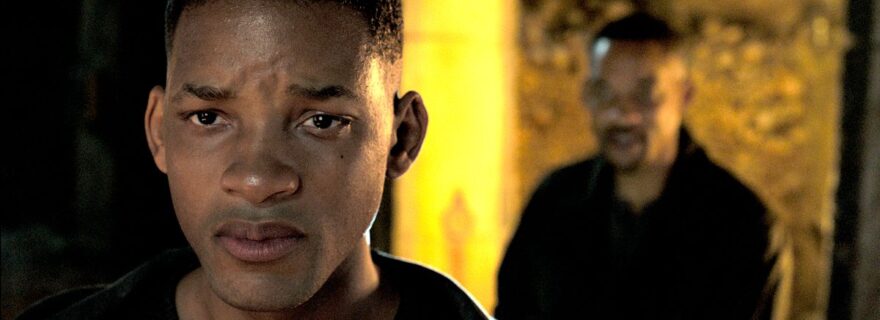Gemini Man
Movie Rating:
2
The original script for Gemini Man was in the hands of Tony Scott back in 1997. After two decades of production hell and a half dozen other directors attached, the sci-fi thriller about a hitman and his clone finally hits the big screen, and the plot is the least interesting or inventive part of the entire thing.
Ang Lee is one of those rare talents always itching to make cinema technology move forward, and he’s part of a small number of artists with the clout to do so who’ve fully embraced digital technology. (Think of him and James Cameron as the yin to Christopher Nolan and Quentin Tarantino’s yang.) Cynically, one could argue that Gemini Man is more a proof of concept than it is an actual movie. Even the first shot feels like it’s trying to be home theater demo material. However, for that minority of us who see the exciting narrative possibilities of both 3D and High Frame Rate cinema, having a multiple Oscar winner like Lee spearheading this charge remains a bit of a thrill.
If you’ve seen the movie’s trailer, you get the gist of the plot. Will Smith is a super assassin, but things go awry and the hunter becomes the hunted, this time by a younger model spawned from his cellular tissue. In 1997, this would have been groundbreaking stuff, but today it feels tired. Fortunately, the story is energized by some wired technology. Lee not only employs the digital de-aging that’s all the rage right now (hello, The Irishman!), but creates a full-on, photorealistic digital actor standing beside his human counterpart. We’ve seen hints of this in other movies, but few if any have gone so hardcore down the cyberthespian route. The process opens up fascinating questions about performance.
Couldn’t Lee have hired another actor to play young Will Smith? Of course. Hell, Jaden’s available. But that wouldn’t have been as interesting to Lee, and it’s clear that this aspect is the thing that’s truly driving his vision. Through the dual Smiths, they explore the challenges of performing multiple characters in different stages of their lives while sharing the screen together.
The movie was shot with a mix of higher than the usual 24 (or, uh, 23.997… or 23.97) frames per second, up to 120. I got a chance to see it projected at 2k/60Hz/3D. Younger viewers won’t notice much of a difference compared to their PlayStation and XBox visuals, while purists will gnash their teeth accordingly. That aforementioned opening shot is of a clam-like building with numerous spans from wall to wall. When the camera pans, there’s no judder or shakiness, simply a smooth transition and a total lack of shearing of the image as the camera moves. Advocates will rejoice, while those craving the more “cinematic” look will be appalled from the first seconds.
Lee has wisely shot his action-packed film to accommodate the higher rate, eschewing whip-pans and other techniques that use motion blur, to instead provide a more sweeping (and, frankly, video game-like) movement throughout the environment. Plenty of POV shots draw the audience in. From an extended motorcycle chase through to fiery explosions and gun fights, the greater clarity, particularly with the addition of 3D, truly does make the film immersive.
Whether this is a good thing for you obviously comes down to taste, but it’s incontrovertible that this is the director’s preferred and intended format. (I’ll leave it to you whether seeing this at 24fps/2D is as egregious as the recent experiments with dubbing and colorizing Fritz Lang’s Metropolis.) Where things get wonky is the larger-than-life performances that are endemic to these kinds of action tentpole movies. There’s nowhere to hide, and with every micro-expression and eye tic picked up in exceptional detail, it’s hard not to feel the end result is too broad, too theatrical without the suspension of disbelief we’ve grown accustomed to after over a century of the blurry compromise of 24fps.
Most reading this site have done worse things than to treat a film as demo material, ignoring any plot elements in favor of peering at the picture quality, and that’s what makes Gemini Man worth discussing above all. It’s not just that the technology overwhelms the narrative; the story is so banal, the ups and downs so predictable, that without these hooks there’d be nothing to talk about at all, save for a warning to not even bother.
Still, if you want to glimpse a bit into an uncertain future via a script out of the past that has aged into something pretty mediocre, Gemini Man is for you. It’s an interesting exercise for those willing to give it a look. While its legacy may be as a footnote in the long line of visual effects extravaganzas, Lee’s insistence on pushing the ball forward should be applauded.




Julian
“Lee (…) creates a full-on, photorealistic digital actor standing beside his human counterpart.”
Question: why does it need to be a digital actor? Couldn’t Lee use the ‘Back to the Future Part II’ technology? Three Michael J. Foxes in one frame, or (in this case) two Will Smiths in one frame?
Josh Zyber
One of the Will Smiths is significantly younger than the other.
Julian
Oh, right, I see, that detail flew over my head.
Bolo
Lee didn’t have to, he wanted to. It would be infinitely easier, cheaper, and probably more convincing to just cast a younger actor and put aging makeup on him to play the older version of himself. But doing things the hard way and the technical wizardry on display are supposed to be the draw here.
Bolo
(or as the review suggests, they could’ve gone the ‘Looper’ route and just had different actors in the roles of the young clone and the old guy.)
Charles M
And the makeup to make Joseph Gordon-Levitt look like Bruce Willis in Looper looked ridiculous.
Julian
So Ang Lee was so preoccupied with whether or not he could, he didn’t stop to think if he should.
cardpetree
That photo preview looks heavily cgi’d to me. How did it look during the actual movie?
Jason Gorber
AuthorThat’s not CGI’d, that IS CGI. That Smith on the left is no more “real” than Jar Jar or Gollum
Shannon Nutt
The problem is that “young” Will Smith doesn’t look all that different from today’s Will Smith. Seems like a waste of dough – they could have just saved on expenses and done some subtle make-up on him.
Josh Zyber
I don’t know. I think it’s pretty startling to see Fresh Prince-era Will Smith starring in a new movie. He’s definitely a little beefier and more weathered today.
Shannon Nutt
Is it worth $140 million (or however much of that budget went to F/X)? Better hope this one rakes in the cash overseas, because it’s going to be lucky to make more than $50 million stateside.
Bolo
It’s not much of a gimmick in itself at this point. This de-aging tech has been on the market awhile now, and has already been used several times specifically so that an old actor can fight his younger self in ‘Tron 2’, ‘Terminator: Genisys’, and ‘Logan’. Of those three films, ‘Logan’ was the only hit, and Jackman in the two roles wasn’t even the selling point for that film.
I too am surprised that somebody was willing to risk 140 million on what is described as a half-assed ‘Bourne’ script dressed up with a gimmick that’s already been done a couple times recently.
Judas Cradle
HFR is actually completely unnatural to our eyes- for good reason.
Wave your hand in front of your face.
See the motion blur? THAT IS HOW WE SEE.
Seeing things in motion without blur looks completely unnatural.
But the worst part is – the clarity pierces the ILLUSION that films strive for.
Instead of seeing (and being immersed) in the action – it feels like a videotaped “behind the the scenes” extra- as we watch the actors on a set.
Pedram
I disagree. The judder of 24fps is completely unnatural. We don’t see at 24fps. It’s just a relic from a bygone era that people have become used to and defend as what films are “supposed” to look like.
It’s all about perception. After growing up with 24fps I’ve now become used to HFR, and movies in HFR or with motion interpolation don’t look unnatural or like a BTS video at all to me. Now 24fps looks weird and full of stutter. You just have to take some time to train your brain.
I’ll be seeing Gemini Man in HFR and 3D, and unlike many who look down their nose at anything over 24fps and call it a video game, I’ll enjoy every frame. As for the movie itself, I can’t say the same until I’ve seen it, but I’m glad Lee had the courage to push the technology forward.